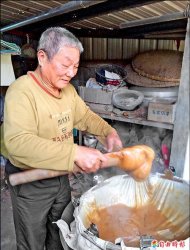http://www.engadget.com/2014/01/29/lenovo-nearing-3-billion-deal-for-motorola/
According to
several sources Lenovo is nearing a rather stunning deal that would put Motorola's cellphone business in its back pocket for roughly $3 billion. Google snatched up Motorola in 2011 for
$12.5 billion. Since then it's slowly broken the company up, scaled back its device lineup and added its massive pile of patents to its legal arsenal. Now, after
losing money for several years straight, Mountain View is reportedly preparing to offload the division on Chinese computer giant Lenovo. The purchase of Motorola will probably also put to bed
rumors of Lenovo purchasing
BlackBerry... at least for a little while. The company has been looking to step up its mobile efforts for the last couple of years, and Motorola's existing infrastructure, patent library and brand recognition should help it make a dent here in the US.
The deal hasn't been officially announced yet, but when (and if) it is There are bound to be
plenty of questions. For one, how will the sale of Motorola to a Chinese firm affect the company's recent efforts to bring
manufacturing jobs back to the US? And how will this impact Google's own expanding manufacturing plans in the future? Or course, we may have also just figured out how exactly Google
convinced Samsung to start putting more focus on Play Services.
Update: Well, that was quick. Google has
confirmed the deal, which will see Motorola Mobility change hands for $2.91 billion. Most of that money will be in the form of cash or a promissory note, but it will also include roughly $750 million worth of Lenovo shares. The deal will also cause more than a few cynics to shout, "I told you so," as Google will be maintaining ownership of "the vast majority" of Motorola's patents. Though, the deal does include a license for that intellectual property and Lenovo will take ownership of Moto's brand and trademarks.
Google also insists that this will not affect its other hardware efforts, including those that might involve wearables and smart home appliances. Though, the tone of the message seems to indicate that Google will be staying out of the mobile phone market for the foreseeable future. An internal memo said that Motorola would be "better served" by Lenovo in the "super competitive" smartphone market. The advanced research unit of the company will be staying in Google's possession, however, to help with those other hardware projects.
For Lenovo, the deal means that it is now not only the largest PC maker, but it will also soon be the third-largest handset manufacturer in the Americas (not to mention the second-largest cellphone company in China as Lenovo). Motorola's existing agreements with retailers and carriers instantly gives the Chinese manufacturer a broad reach into mobile markets all over the globe. The company also expressed confidence in Moto's existing team, and in the short term, it does not appear there are plans to close its Chicago headquarters or start laying off employees, including the executives. Though, things sound less rosy for employees at the Texas plant where the Moto X is manufactured. The company said only that it would do what made sense to grow the brand, and would not commit to keeping existing manufacturing jobs in the US. The current plan appears to be to maintain the Motorola brand where it enjoys recognition and success.

